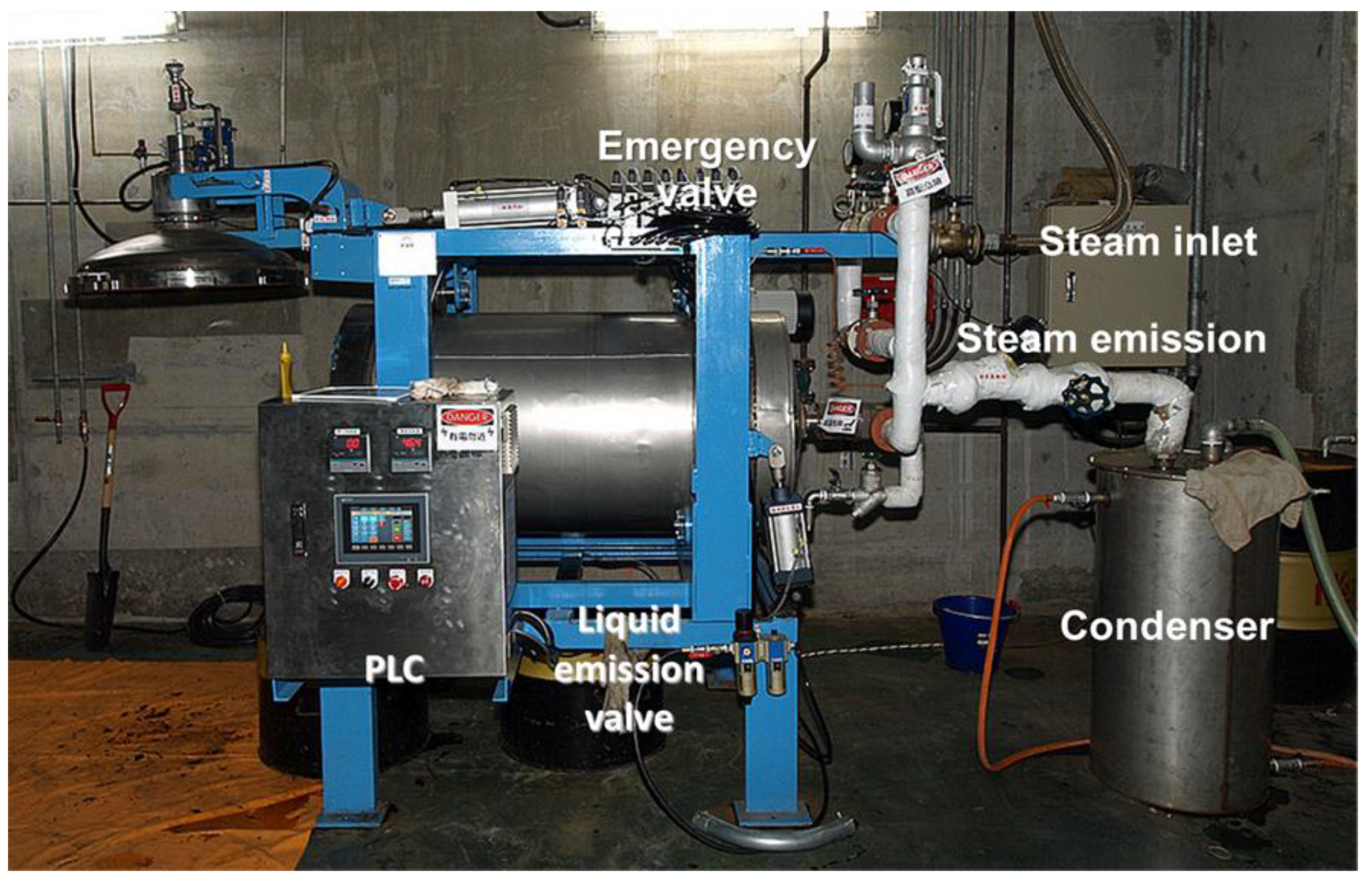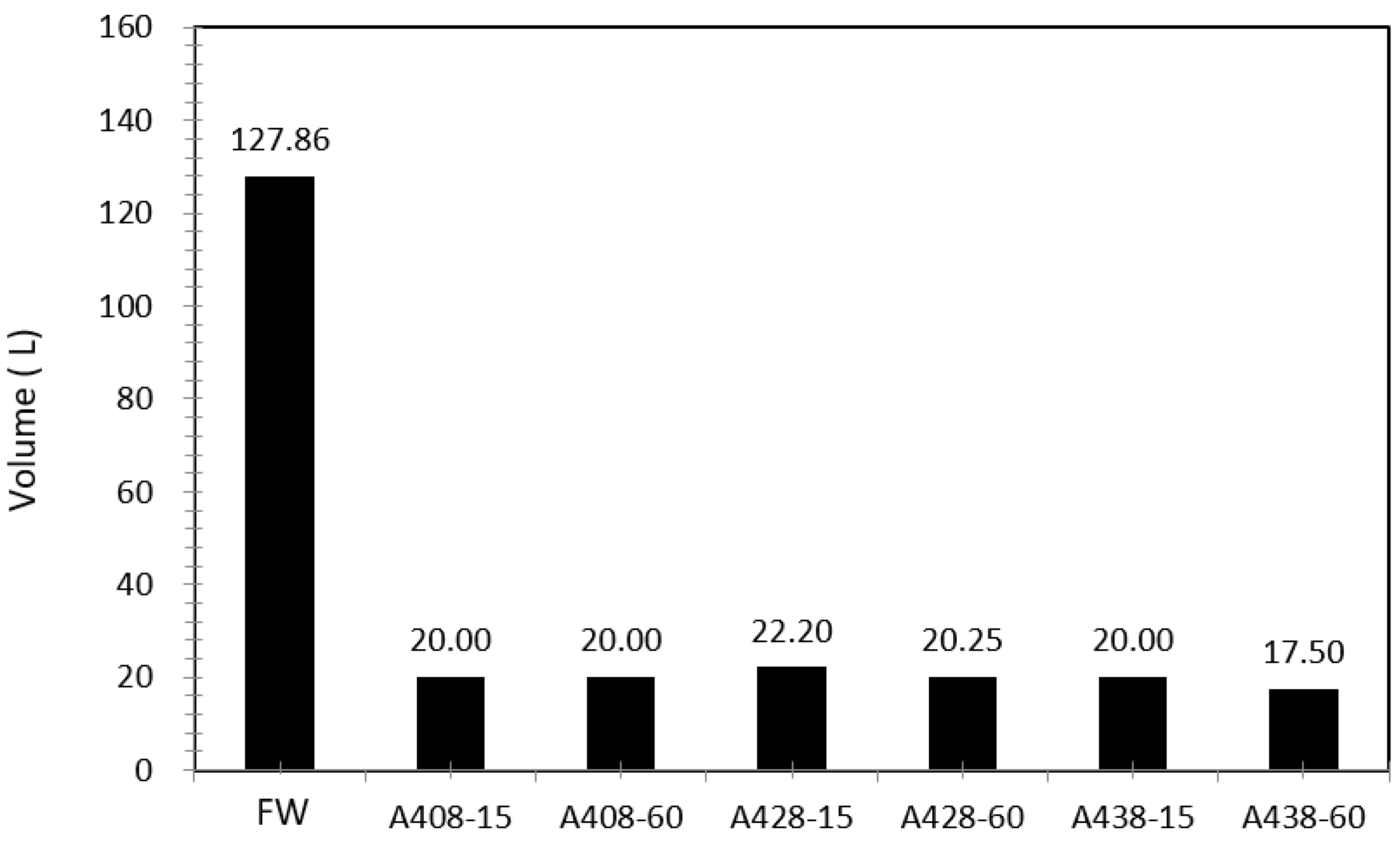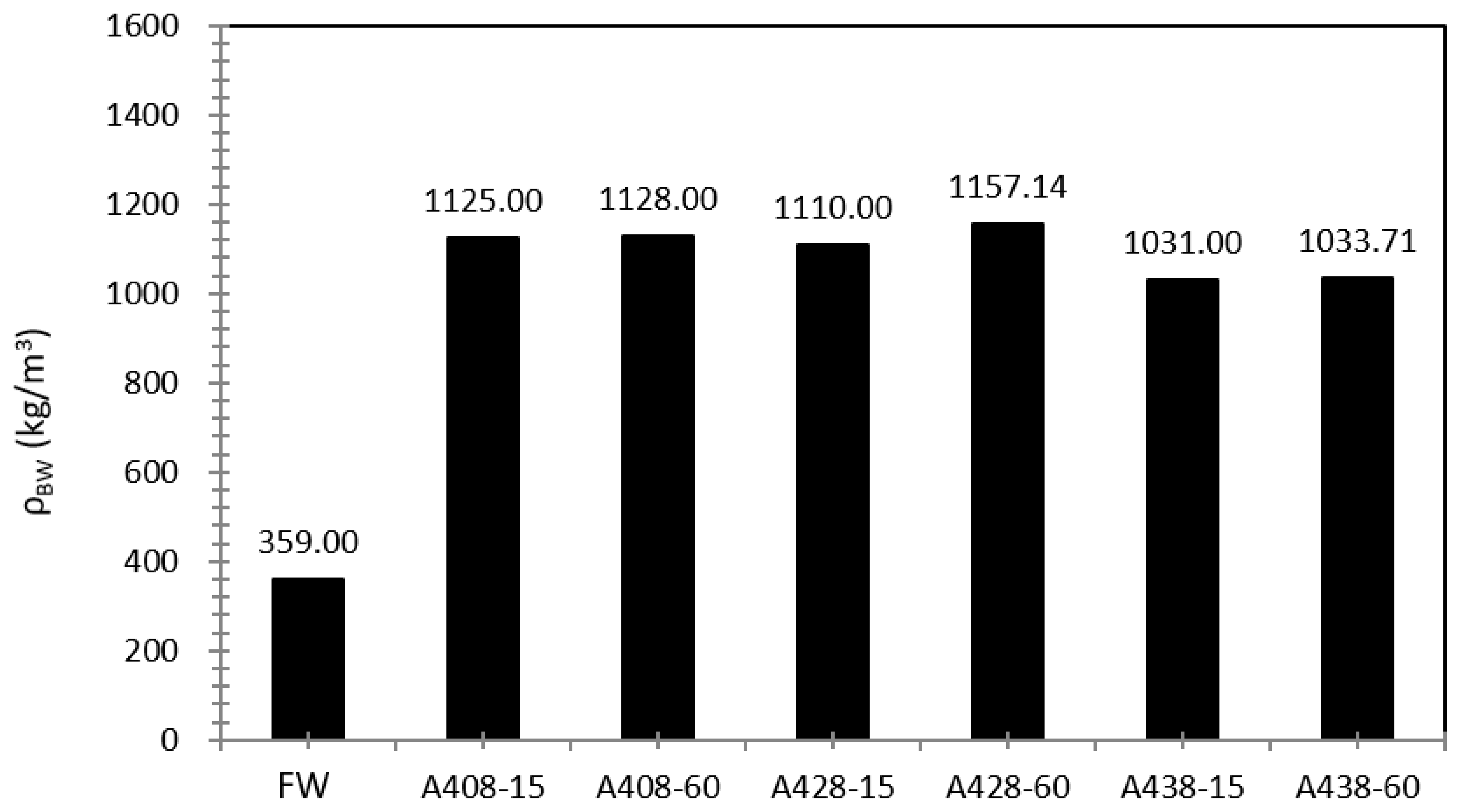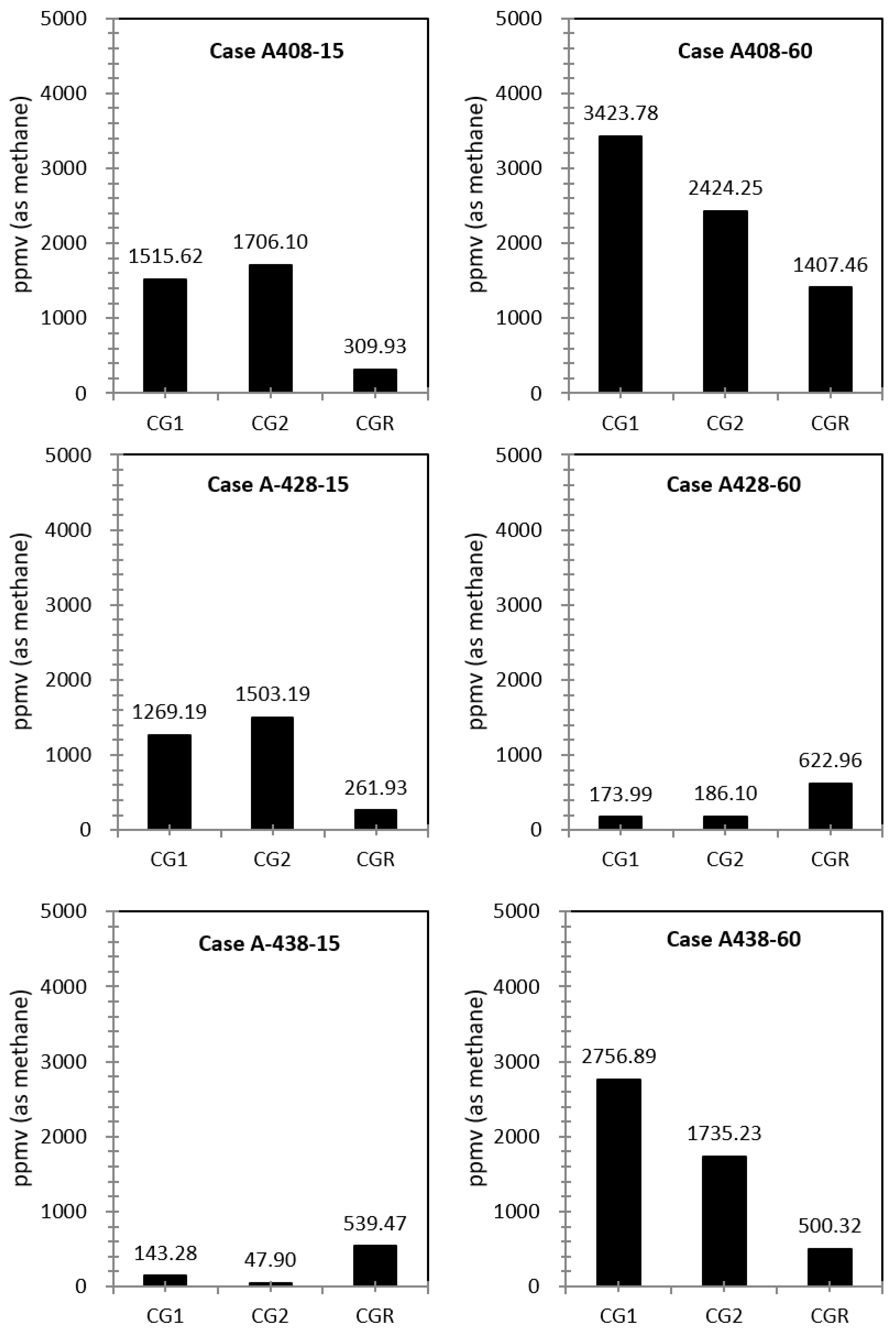A Pilot Plant Study on the Autoclaving of Food Wastes for Resource Recovery and Reutilization
Abstract
1. Introduction
2. Materials and Methods
2.1. Materials and Experiments
2.2. Analyses
2.2.1. Solid Analyses
2.2.2. Liquid Analyses
2.2.3. Gas Analyses
3. Results and Discussion
3.1. Properties of FW
3.2. Autoclaving of FW
3.2.1. Volume Reduction of FWA
3.2.2. Change of Some Basic Properties of FWA
3.2.3. Energy Intensity of FWA
3.2.4. Comparison of Properties of FWA with Compost Standards
3.2.5. Properties of Autoclaved and Condensed Liquid Products
3.2.6. Properties of Gases Formed
4. Conclusions
Author Contributions
Acknowledgments
Conflicts of Interest
Nomenclature
| AT-t | Autoclaving at T K and t min (e.g., A408-15: at 408 K and 15 min) |
| CG1, CG2 | concentrations of G1, G2 (ppmv) |
| CGR | Concentrations of GR (ppmv) |
| COD | Chemical oxygen demand (mg/L) |
| EC | Electrical conductivity (μS/cm) |
| G1, G2 | Released gases after condenser as pressures in autoclave were reduced to P1 and P2 after finishing the autoclaving at setting time |
| GR | Gas in autoclave after opening the reactor lid at the end of autoclaving as the pressure in autoclave was reduced to ambient |
| HHDM | Higher heating value per mass in dry basis (kcal/kg) |
| HHDV | Higher heating value per volume in dry basis (kcal/kg) |
| HHWM | Higher heating value per mass in wet basis (kcal/kg) |
| MA | Ash (wt.%) |
| MC | Combustibles (wt.%) |
| MFC | Fixed carbon (wt.%) |
| MVM | Volatile matters (wt.%) |
| MW | Water content (wt.%) |
| NH3-N | ammonium nitrogen (mg/L) |
| P | Steam pressure for autoclaving (kg/cm2, gauge) |
| P1, P2 | Two pressures in autoclave as gas were released after finishing the autoclaving at setting time (kg/cm2, gauge) |
| r | Rotation speed of autoclave (rpm) |
| T | Autoclaving temperature (K or °C) |
| THCs | Total hydrocarbons (ppmv) |
| TOC | Total organic carbons (mg/L) |
| t | Autoclaving times (min) |
| VBW | Wet bulk volume (L) |
| ρBD | Dry bulk density (kg/m3) |
| ρBW | Wet bulk density (kg/m3) |
Abbreviations
| ASTM | American Society for Testing and Materials |
| CNS | Chinese National Standards |
| FW | Food wastes |
| FWA | Autoclaved food wastes |
| LC | Condensed liquid from the released gas from autoclave |
| LA | Autoclaved liquid product separated from FWA |
| HTL | Hydrothermal liquefaction |
| IWPB | Initiative Wood Pellet Buyers |
| MSW | Municipal solid wastes |
| NIEA | National Institute of Environmental Analysis |
| RDF | Refused derived fuel |
| SRF | Solid recovered fuel |
| TBSMI | Taiwan Bureau of Standards, Metrology, and Inspection |
References
- Chang, C.Y.; Li, Y.S.; Shie, J.L.; Chen, Y.H.; Chang, C.C. The Evaluation of Autoclaving Process for Municipal Solid Waste Separation; Report No. EPA-98-1605-02-02; Environmental Protection Agency: Washington, DC, USA, 2010. (In Chinese)
- Eley, M.H.; Holloway, C.C. Treatment of municipal solid wastes by steam classifi-cation for recycling and biomass utilization. Appl. Biochem. Biotechnol. 1988, 17, 125–135. [Google Scholar] [CrossRef]
- Eley, M.H. An improved prototype apparatus and process for separating cellu-losic materials from municipal solid waste. Appl. Biochem. Biotechnol. 1994, 45–46, 69–79. [Google Scholar] [CrossRef]
- Environments Consulting Ltd.; Department for Environment, Food and Rural Affairs (Defra). Mechanical heat Treatment of Municipal Solid Waste; Environments Consulting Ltd.: Cambourne, UK, 2007. Available online: http://www.defra.gov.uk/environment/waste/residual/newtech/docu-ments/mht.pdf (accessed on 22 August 2018).
- Environments Consulting Ltd.; Department for Environment, Food and Rural Affairs (Defra). Introductory Guide to Options for the Diversion of Biodegradable Municipal Waste from Landfill; Environments Consulting Ltd.: Cambourne, UK, 2007. Available online: http://www.defra.go-v.uk/environment/waste/residual/newtech/documents/introductory-guide-2007.pdf (accessed on 22 August 2018).
- Garg, A.; Smith, R.; Hill, D.; Simms, N.; Pollard, S. Wastes as co-fuels: The policy framework for solid recovered fuel (SRF) in Europe, with UK implications. Environ. Sci. Technol. 2007, 41, 4868–4874. [Google Scholar] [CrossRef] [PubMed]
- Holloway, C.C.; Holloway, L.B. Process for Separating and Recovering Organics and Inorganics from Waste Material. U.S. Patent 4,342,830, 3 August 1982. [Google Scholar]
- Hung, Z.S.; Chang, C.C.; Ho Chang, C.F.; Wang, Y.C.; Chang, C.Y.; Ji, D.R. Autoclaving of waste plastics-free papers for the resource recovery and reutilization. Fresen. Environ. Bull. 2012, 21, 2486–2493. [Google Scholar]
- Hung, Z.S.; Chang, C.C.; Ho Chang, C.F.; Lin, Y.S.; Ji, D.R.; Chang, C.Y.; Tseng, J.Y.; Chiang, S.W.; Shie, J.L.; Chen, Y.H.; Ko, C.H.; Li, Y.S. Autoclaving treatment of wasted disposable bamboo chopsticks. J. Taiwan Inst. Chem. Eng. 2013, 44, 1010–1015. [Google Scholar] [CrossRef]
- Papageorgiou, A.; Barton, J.R.; Karagiannidis, A. Assessment of the greenhouse effect impact of technologies used for energy recovery from municipal waste: A case for England. J. Environ. Manag. 2009, 90, 2999–3012. [Google Scholar] [CrossRef] [PubMed]
- Chang, C.Y.; Li, Y.S.; Wu, C.H.; Shie, J.L.; Chen, Y.H.; Lin, F.C. Low-temperature Biomass Pyrolysis Test Facility System Construction for the Solid Alternative Biofuel Production; Report No. EPA- 99-1605-02-03; Environmental Protection Agency: Washington, DC, USA, 2010. (In Chinese)
- Chen, Y.H.; Chang, C.C.; Chang, C.Y.; Yuan, M.H.; Ji, D.R.; Shie, J.L.; Lee, C.H.; Chen, Y.H.; Chang, W.R.; Yang, T.Z.; et al. Production of a Solid Bio-fuel from Waste Bamboo Chopsticks by Torrefaction for Cofiring with Coal. J. Anal. Appl. Pyrol. 2017, 126, 315–322. [Google Scholar] [CrossRef]
- Chang, C.C.; Chen, C.P.; Yang, C.S.; Chen, Y.H.; Huang, M.; Chang, C.Y.; Shie, J.L.; Yuan, M.H.; Chen, Y.H.; Ho, C.; et al. Conversion of waste bamboo chopsticks to bio-oil via catalytic hydrothermal liquefaction using K2CO3. Sustain. Environ. Res. 2016, 26, 262–267. [Google Scholar] [CrossRef]
- Gao, W.; Chen, Y.; Zhan, L.; Bian, X. Engineering properties for high kitchen waste content municipal solid waste. J. Rock Mechan. Geotech. Eng. 2015, 7, 646–658. [Google Scholar] [CrossRef]
- TEPA. Properties of Municipal Solid Waste in Environment Statistics. Environmental Protection Administration of Taiwan (TEPA): Taiwan. Available online: http://www.epa.gov.tw /en/statistics/c4020.pdf (accessed on 17 August 2018).
- Russ, W. Food waste as a renewable energy source. Thermoteiinika 2006, 1–2, 66–73. [Google Scholar]
- Sun, Y.; Cheng, J. Hydrolysis of lignocellulosic materials for ethanol production: A review. Bioresour. Technol. 2002, 83, 1–11. [Google Scholar]
- IWPB Initiative Wood Pellet Buyers (IWPB). IEE Pellcert Europe (2012–2014): Standardizing Wood Pellets Trading in Europe. Available online: http://www.laborelec.be/ENG/services/biomass-analysis/.wood-pellet-standards/ (accessed on 22 August 2018).
- TTIA. Irrigate Water Quality Standards, Taitung Irrigation Association (TTIA), Taiwan. Available online: http://www.ttia.gov.tw/page8-5.php (accessed on 22 August 2018).
- Bougrier, C.; Albasi, C.; Delgenes, J.P.; Carrère, H. Effect of ultrasonic, thermal and ozone pre-treatments on waste activated sludge solubilisation and anaerobic digestion biodegradability. Chem. Eng. Process. 2006, 45, 711–718. [Google Scholar] [CrossRef]
- Le, T.M.; Vo, P.T.; Tran, L.T.; Truong, H.T.; Le, T.T.X.; Nguyen, T.M.; Do, M.V.; Chang, C.C.; Chen, Y.H.; Chang, C.Y. Effect of assisted ultrasonication and ozone pre-treatments on sludge characteristics and yield of biogas production with waste sludge from fishery wastewater treatment plant. 2018; in press. [Google Scholar]




| FW | A408-15 c | A408-60 | A428-15 | A428-60 | A438-15 | A438-60 | ||
|---|---|---|---|---|---|---|---|---|
| Proximate analysis a (wt.%) | Combustibles, MC | 6.4347 | 9.1280 | 6.3803 | 8.3441 | 7.8499 | 7.9829 | 7.1092 |
| Fixed carbon, MFC | 0.1708 | 0.1871 | 0.2244 | 0.2531 | 0.2604 | 0.2569 | 0.2220 | |
| Volatile matters, MVM | 6.2639 | 8.9409 | 6.1559 | 8.0910 | 7.5895 | 7.7260 | 6.8872 | |
| Ash, MA | 0.8339 | 0.9056 | 0.8409 | 0.8668 | 1.0020 | 1.0351 | 0.9491 | |
| Water content, MW | 92.7314 | 89.9664 | 92.7788 | 90.7891 | 91.1481 | 90.9820 | 91.9417 | |
| Ultimate analysis b (wt.%) | C | 37.545 ± 0.136 | 39.917 ± 0.115 | 39.202 ± 0.066 | 39.887 ± 0.047 | 40.626 ± 0.085 | 36.936 ± 0.261 | 42.021 ± 0.748 |
| H | 5.688 ± 0.086 | 5.903 ± 0.064 | 5.753 ± 0.056 | 5.863 ± 0.051 | 5.786 ± 0.001 | 5.635 ± 0.081 | 5.799 ± 0.081 | |
| O | 51.582 | 50.059 | 50.917 | 50.477 | 49.678 | 53.436 | 48.416 | |
| N | 3.514 ± 0.013 | 3.236 ± 0.029 | 3.283 ± 0.030 | 3.049 ± 0.083 | 3.103 ± 0.116 | 3.152 ± 0.033 | 3.024 ± 0.004 | |
| S | 1.673 ± 0.158 | 0.887 ± 0.056 | 0.846 ± 0.008 | 0.725 ± 0.037 | 0.808 ± 0.034 | 0.816 ± 0.040 | 0.742 ± 0.060 | |
| Fiber analysis b | Hemicellulose | 3.3881 | 0.9686 | 0.0473 | 0.0589 | 3.8682 | 0.7695 | 1.9842 |
| Cellulose | 47.9564 | 42.2591 | 40.6410 | 47.4245 | 44.1061 | 45.2092 | 38.7206 | |
| Lignin | 22.9077 | 14.7414 | 16.0123 | 17.1644 | 26.1972 | 16.2790 | 24.2762 | |
| Heating value | HHDM (kcal/kg) | 3954.66 ± 8.09 | 3761.81 ± 954.58 | 3351.37 ± 61.37 | 3449.80 ± 200.53 | 2976.66 ± 436.98 | 3065.04 ± 367.58 | 2800.27 ± 158.48 |
| HHDV (kcal/m3) | 103194.33 | 424625.63 | 272987.43 | 352711.78 | 304895.82 | 284973.23 | 233261.01 | |
| HHWM (kcal/kg) | 287.45 | 377.45 | 242.01 | 317.76 | 263.49 | 276.40 | 225.65 |
| Property in Wet Basis | Standard | FW | A408-15 | A408-60 | A428-15 | A428-60 | A438-15 | A438-60 |
|---|---|---|---|---|---|---|---|---|
| H2O (wt.%) | <40 | 92.7314 | 89.9664 | 92.7788 | 90.7891 | 91.1481 | 90.9820 | 91.9417 |
| C/N (wt.%/wt.%) | 10–25 | 10.68 | 12.34 | 11.94 | 13.08 | 13.09 | 11.72 | 13.90 |
| N * (wt.%) | 0.6–5.0 | 3.514 ± 0.013 | 3.236 ± 0.029 | 3.283 ± 0.030 | 3.049 ± 0.083 | 3.103 ± 0.116 | 3.152 ± 0.033 | 3.024 ± 0.004 |
| P (mg/kg) | 3.91 × 103 | 4.20 × 103 | 4.54 × 103 | 3.85 × 103 | 5.03 × 103 | 4.94 × 103 | 5.76 × 103 | |
| P2O5 (wt.%) | 0.3–6.0 | 8.96 × 10−3 | 9.62 × 10−3 | 1.04 × 10−2 | 8.82 × 10−3 | 1.15 × 10−2 | 1.13 × 10−2 | 1.32 × 10−2 |
| K (mg/kg) | 2.92 × 104 | 1.80 × 104 | 1.97 × 104 | 1.60 × 104 | 1.59 × 104 | 1.99 × 104 | 1.79 × 104 | |
| K2O (wt.%) | 0.3–4.0 | 3.52 × 10−2 | 2.17 × 10−2 | 2.37 × 10−2 | 1.93 × 10−2 | 1.92 × 10−2 | 2.40 × 10−2 | 2.16 × 10−2 |
| Cu (mg/kg) | <100 | 42.4 | 31.7 | 30.5 | 29.8 | 52.5 | 56.5 | 50.9 |
| Cr (mg/kg) | <150 | 8.00 | 7.61 | 5.77 | 5.74 | 7.73 | 6.65 | 7.52 |
| Pb (mg/kg) | <150 | 5.84 | 5.89 | 6.74 | 7.16 | 9.86 | 5.44 | 11.1 |
| Cd (mg/kg) | <2.0 | <0.70 | <0.70 | <0.70 | <0.70 | <0.70 | <0.70 | <0.70 |
| Zn (mg/kg) | <250 | 41.3 | 75.7 | 94.0 | 77.2 | 139 | 79.0 | 369 |
| Ni (mg/kg) | <25.0 | 14.3 | 12.2 | 18.0 | 12.6 | 20.3 | 22.1 | 19.5 |
| As (mg/kg) | <25.0 | <1.7 | <1.7 | <1.7 | <1.7 | <1.7 | <1.7 | ND |
| Hg (mg/kg) | <1.0 | <0.015 | <0.015 | 0.025 | <0.015 | 0.021 | 0.015 | <0.015 |
| Autoclaved Liquid (LA) | |||||||
| Condition | Item | ||||||
| Temperature (K) | Time (min) | Rotation Speed (rpm) | pH | Electrical Conductivity (μS/cm) | COD (mg/L) | TOC (mg/L) | NH3-N (mg/L) |
| 408 | 15 | 7 | 4.94 | 9.84 × 103 | 1.04 × 104 | 1.21 × 103 | 2.70 × 102 |
| 408 | 60 | 7 | 4.73 | 9.15 × 103 | 2.00 × 104 | 9.38 × 102 | - |
| 428 | 15 | 7 | 4.72 | 9.68 × 103 | 2.16 × 104 | 1.11 × 103 | 3.10 × 102 |
| 428 | 60 | 7 | 4.44 | 9.17 × 103 | 1.96 × 104 | 9.48 × 102 | - |
| 438 | 15 | 7 | 5.18 | 9.86 × 103 | 2.25 × 104 | 1.04 × 103 | - |
| 438 | 60 | 7 | 4.42 | 9.20 × 103 | 2.12 × 104 | 9.70 × 102 | - |
| Condensed Liquid (LC) | |||||||
| Condition | Item | ||||||
| Temperature (K) | Time (min) | Rotation Speed (rpm) | pH | Electrical Conductivity (μS/cm) | COD (mg/L) | TOC (mg/L) | NH3-N (mg/L) |
| 408 | 15 | 7 | 7.26 | 2.67 × 102 | 3.06 × 102 | 1.33 × 102 | 3.00 |
| 408 | 60 | 7 | 6.68 | 2.65 × 102 | 6.27 × 102 | 2.24 × 102 | - |
| 428 | 15 | 7 | 8.54 | 2.48 × 102 | 3.90 × 102 | 1.51 × 102 | 3.50 |
| 428 | 60 | 7 | 8.29 | 2.39 × 102 | 8.27 × 102 | 2.57 × 102 | - |
| 438 | 15 | 7 | 8.78 | 2.77 × 102 | 5.07 × 102 | 1.87 × 102 | - |
| 438 | 60 | 7 | 8.19 | 2.44 × 102 | 8.67 × 102 | 2.79 × 102 | - |
| Condition | 408 K, 15 min | 408 K, 60 min | 428 K, 15 min | 428 K, 60 min | 438 K, 15 min | 438 K, 60 min | ||||||||||||||
|---|---|---|---|---|---|---|---|---|---|---|---|---|---|---|---|---|---|---|---|---|
| Rotation Speed | 7 rpm | 7 rpm | 7 rpm | 7 rpm | 7 rpm | 7 rpm | ||||||||||||||
| Limonene | C10H16 | Alkene | ● 1 | ● 2 | ● 3 | ● 1 | ● 2 | ● 3 | ● 1 | ● 2 | ● 3 | ● 1 | ● 2 | ● 3 | ● 1 | ● 2 | ● 3 | ● 1 | ● 2 | ● 3 |
| α-pinene | C10H16 | ● | ● | ● | ● | ● | ● | ● | ● | ● | ● | ● | ● | ● | ● | ● | ||||
| 1R-α-pinene | C10H16 | ● | ● | |||||||||||||||||
| 1S-α-pinene | C10H16 | ● | ||||||||||||||||||
| β-pinene | C10H16 | ● | ● | ● | ||||||||||||||||
| 2-methyl propanal | C4H8O | Aldehyde | ● | ● | ● | ● | ● | ● | ● | ● | ● | ● | ● | ● | ● | ● | ||||
| 3-methyl butanal | C5H10O | ● | ● | ● | ● | ● | ● | ● | ● | ● | ● | ● | ● | ● | ● | |||||
| 2-methyl butanal | C5H10O | ● | ● | ● | ● | ● | ● | |||||||||||||
| Carbon dioxide | CO2 | Others | ● | ● | ● | ● | ● | ● | ● | ● | ● | ● | ||||||||
| Alcohol | C2H6O | ● | ● | |||||||||||||||||
| Dimethyl sulfide | C2H6S | ● | ● | ● | ● | ● | ● | ● | ● | ● | ● | ● | ● | |||||||
| Dimethyl disulfide | C2H6S2 | ● | ● | ● | ● | ● | ● | ● | ● | ● | ● | ● | ● | ● | ● | ● | ||||
| 2,3-butanedione | C4H6O2 | ● | ● | ● | ||||||||||||||||
| Nitrogen | N2 | ● | ● | ● | ● | ● | ● | ● | ● | ● | ● | ● | ● | ● | ● | ● | ● | ● | ● | |
| Water | H2O | ● | ● | ● | ● | ● | ● | ● | ● | ● | ● | ● | ● | ● | ● | ● | ● | ● | ● | |
© 2018 by the authors. Licensee MDPI, Basel, Switzerland. This article is an open access article distributed under the terms and conditions of the Creative Commons Attribution (CC BY) license (http://creativecommons.org/licenses/by/4.0/).
Share and Cite
Chang, C.-C.; Chen, Y.-H.; Lin, Y.-S.; Hung, Z.-S.; Yuan, M.-H.; Chang, C.-Y.; Li, Y.-S.; Shie, J.-L.; Chen, Y.-H.; Wang, Y.-C.; et al. A Pilot Plant Study on the Autoclaving of Food Wastes for Resource Recovery and Reutilization. Sustainability 2018, 10, 3566. https://doi.org/10.3390/su10103566
Chang C-C, Chen Y-H, Lin Y-S, Hung Z-S, Yuan M-H, Chang C-Y, Li Y-S, Shie J-L, Chen Y-H, Wang Y-C, et al. A Pilot Plant Study on the Autoclaving of Food Wastes for Resource Recovery and Reutilization. Sustainability. 2018; 10(10):3566. https://doi.org/10.3390/su10103566
Chicago/Turabian StyleChang, Chia-Chi, Yen-Hau Chen, Yi-Shiou Lin, Zang-Sei Hung, Min-Hao Yuan, Ching-Yuan Chang, Yuan-Shen Li, Je-Lueng Shie, Yi-Hung Chen, Yen-Chi Wang, and et al. 2018. "A Pilot Plant Study on the Autoclaving of Food Wastes for Resource Recovery and Reutilization" Sustainability 10, no. 10: 3566. https://doi.org/10.3390/su10103566
APA StyleChang, C.-C., Chen, Y.-H., Lin, Y.-S., Hung, Z.-S., Yuan, M.-H., Chang, C.-Y., Li, Y.-S., Shie, J.-L., Chen, Y.-H., Wang, Y.-C., Ko, C.-H., Lin, F.-C., Ho, C., Liu, B.-L., Liu, K.-W., & Wang, S.-G. (2018). A Pilot Plant Study on the Autoclaving of Food Wastes for Resource Recovery and Reutilization. Sustainability, 10(10), 3566. https://doi.org/10.3390/su10103566








